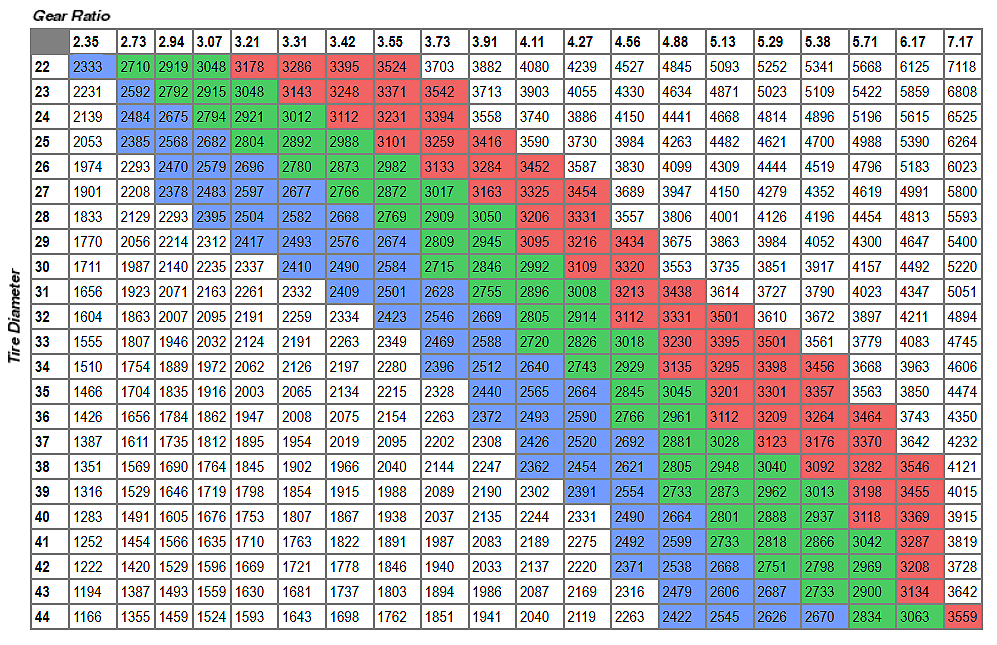Brain75
Well-Known Member
- Joined
- Aug 8, 2024
- Messages
- 2,012
- City
- ~Sterling, Colorado
- Vehicle Year
- 1990
- Engine
- 2.9 V6
- Transmission
- Manual
- Tire Size
- 215/70R14
I figured my truck was turnin' out too high an RPM for any chance at a decent MPG goin' 75mph down the road, so turned to the calculators and charts here on TRS only to find they were a little lacking... I whipped up a quick XL spreadsheet and then said, why not share it back to the community... so here is a discussion, request for more info, additions, and feedback opportunity to improve it before I tie up even more of Jim's time...
this chart:
 has some gear ratios that as best I can tell are irrelevant to us, and some tire sizes past the far end of what a guy could squeek under a ranger, along with some missing data and the fact it is static hard locked to 65mph, and a final drive ratio of 1:1 (no overdrive).
has some gear ratios that as best I can tell are irrelevant to us, and some tire sizes past the far end of what a guy could squeek under a ranger, along with some missing data and the fact it is static hard locked to 65mph, and a final drive ratio of 1:1 (no overdrive).
So my XL spreadsheet addressed those and after a couple hours or polishing off some rusty javascript I have a working copy that is dynamic on both the final speed and final drive ratio.
I can't post the HTML here in a working format (thankfully for safety measures to protect Jim/the site), so here is a screenshot.

My questions to the community:
A) missing info - anyone know the ring and pinion teeth count for sure of the 2.73 and 3.31 rear diff gearsets? (I put in my best SWAG - Scientific Wild Ass Guess)
B) does anyone make gear sets further out on the extremes than 2.73 or 5.13 AND do you want them in the chart?
(if so I am gonna need teeth counts)
C) I dropped some ratios that don't look to exist in 7.5"/8.8" or 9" - are any of those ratios needed to be put back? (if so what are they off of so I can add them and info)
D) really common tire sizes, I kinda knew the most common 1st gen / 2nd gen / 5th gen sizes but not so much on 3rd, etc - care to share those and I will add them.
(I know if you got a splash or stx or tow package they got different sizes so "stock" OEM is 200 different sizes, only looking for the 90% most common, 1 per generation)
Also if anyone can argue that 90% of the rock crawler crowd all look at XYZ size that is not on the chart and it is super common - share that size and I will add.
The light blue MPH and Final (OD) Ratio are user modifiable so you can play with swapping trans out to see the differences between Trans A and B.
The pink tire sizes are also user modifiable so you can plug in a tire size I didn't put in.
I "think" everything else is self explanatory, but now is the time to ask so if it isn't clear I can type up a little whatzit/how-to-do.
this chart:

Gear Ratio & RPM Guide For Larger Tires - The Ranger Station
This Gear Ratio & RPM Guide will enable you to see how many RPM's your engine will turn based on gear ratio and tire size.
www.therangerstation.com
So my XL spreadsheet addressed those and after a couple hours or polishing off some rusty javascript I have a working copy that is dynamic on both the final speed and final drive ratio.
I can't post the HTML here in a working format (thankfully for safety measures to protect Jim/the site), so here is a screenshot.
My questions to the community:
A) missing info - anyone know the ring and pinion teeth count for sure of the 2.73 and 3.31 rear diff gearsets? (I put in my best SWAG - Scientific Wild Ass Guess)
B) does anyone make gear sets further out on the extremes than 2.73 or 5.13 AND do you want them in the chart?
(if so I am gonna need teeth counts)
C) I dropped some ratios that don't look to exist in 7.5"/8.8" or 9" - are any of those ratios needed to be put back? (if so what are they off of so I can add them and info)
D) really common tire sizes, I kinda knew the most common 1st gen / 2nd gen / 5th gen sizes but not so much on 3rd, etc - care to share those and I will add them.
(I know if you got a splash or stx or tow package they got different sizes so "stock" OEM is 200 different sizes, only looking for the 90% most common, 1 per generation)
Also if anyone can argue that 90% of the rock crawler crowd all look at XYZ size that is not on the chart and it is super common - share that size and I will add.
The light blue MPH and Final (OD) Ratio are user modifiable so you can play with swapping trans out to see the differences between Trans A and B.
The pink tire sizes are also user modifiable so you can plug in a tire size I didn't put in.
I "think" everything else is self explanatory, but now is the time to ask so if it isn't clear I can type up a little whatzit/how-to-do.












